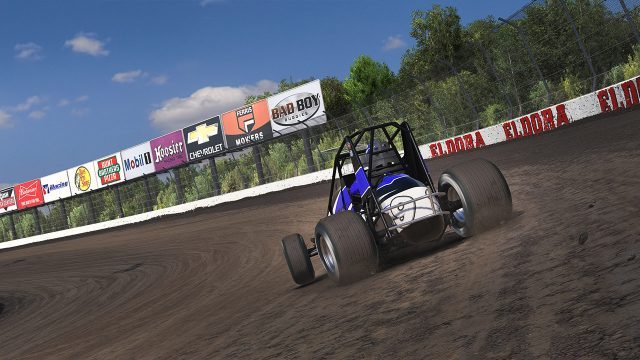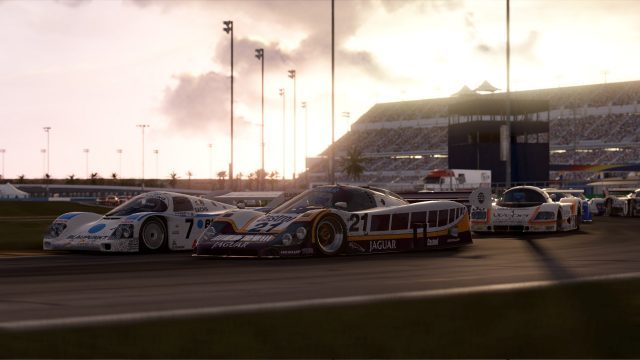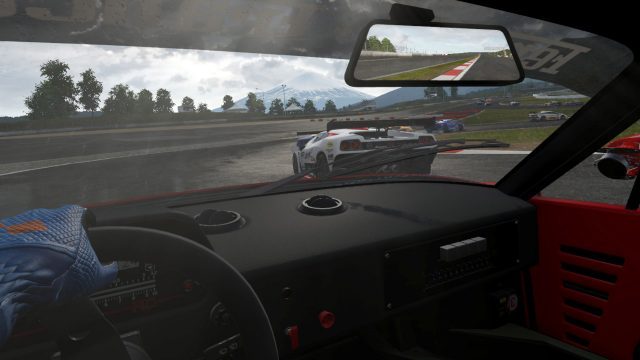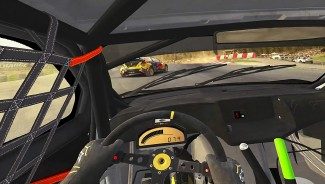2. iRacing
Laser-scanned cars and tracks was once a major selling point, but most other sims use similar data-acquisition techniques today. The quality of track and car creation is still arguably the best in the business, but iRacing comfortably retains its place as the premier PC racing simulation due to its multiplayer-only approach. The subscription service and content purchases make it by far the most expensive way to go sim racing (although it is cheap – and often free – to try), but the quality of racing it delivers as a result of its driver rating systems and server infrastructure make it the most reliable. If you can dedicate the time and money, iRacing will likely reward you with the most consistent, competitive racing available.
Even ignoring its inherent advantage in delivering realistic track action due to its online-only service, iRacing’s VR implementation is capable of delivering a remarkably immersive sense of real racing. Its visuals can’t match Project CARS 2 (despite being similarly demanding on hardware), but it does maintain a very crisp image quality that lends itself well to serious racing over extended sessions. While supporting supersampling and MSAA, it also features a well-judged, post-process sharpening effect that overcomes some of the resolution limitations of the first generation of VR headsets.

Dirt oval racing was recently introduced to the subscription service, to wide acclaim. As much of dirt oval driving involves an oversteer slide, you end up looking sideways as much as you look forward, so VR is ideal. Plus, mud starts to build up on your visor, which can be cleared with a ‘tear-off’ button, a convincing effect in VR.
The ease of use doesn’t match Project CARS 2, as the new UI is still a work in progress and the in-engine menu system isn’t newcomer-friendly, but it is fully-featured. The in-depth camera controls combined with the best-in-class replay system mean that iRacing is a joy to use in VR even when you’re not driving. In the car, the cockpits (at least the more recent cars) are incredibly detailed, the driver model is convincing, with some of the most natural steering animation available. The mirrors render correct 3D views (including the reflection of your body and car) and react to positional tracking, but sadly aren’t stereoscopic.
iRacing’s surround audio system is functional in VR, but it is a basic implementation at this point, beaten by the more advanced spatial audio in Project CARS 2. However, iRacing has more accurate audio samples overall, and more convincing audio responses to drivetrain simulation.
1. Project CARS 2

Project CARS 2 is an ambitious racing sim, attempting to represent 29 motorsport series across 9 racing disciplines. Renowned for its stunning graphics, Project CARS 2 is capable of delivering some of the most realistic visuals in sim racing, with dramatic changes in atmosphere through its dynamic weather and 24-hour lighting cycle. With huge improvements to the physics, Project CARS 2 has firmly established its place in the list of realistic simulations, but it remains one of the more accessible titles, with forgiving handling characteristics at the limit. Unfortunately, Slightly Mad Studios’ second attempt at a cutting-edge racing sim is far from perfect, with plenty of bugs and some frustrating AI.
As a VR showcase, it’s almost entirely good news. Image quality problems of Project CARS (2015) have been addressed, with a more effective approach to supersampling and anti-aliasing, and overall performance is more consistent. Most significantly, the game no longer struggles to hold frame rate during wet conditions, and the low resolution alpha effects of water spray have been resolved.
Project CARS 2 received several other notable VR improvements over the original – the driver model is more realistic – probably the most photorealistic model on the list – and the excessively elaborate over-arm steering animation has been fixed. Now the driver maintains grip on the wheel at ‘9 and 3’ beyond 90 degrees each way, making it consistent with the animations in iRacing, Assetto Corsa and Live For Speed.
 Mirrors have been greatly improved, being adjustable and connected to head tracking – but they are not stereoscopic. Essentially, they function like higher quality versions of iRacing’s mirrors, although they don’t show the reflection of your own car.
Mirrors have been greatly improved, being adjustable and connected to head tracking – but they are not stereoscopic. Essentially, they function like higher quality versions of iRacing’s mirrors, although they don’t show the reflection of your own car.
While the audio quality doesn’t match iRacing’s samples, the spatial audio system is commendable – it’s the only sim on the list where you can hear your engine sound coming from the correct point in virtual space.
With the ability to operate the entire game in VR, including all the menus, its numerous considerations to accommodate the VR user (e.g. quick access VR-specific menu options), along with an overall stunning presentation, it is arguably the most ‘complete’ VR experience on this list, and certainly the slickest. Issues with HUD customisation and HUD depth ‘clipping’ and the limited options for replay/broadcast camera angles are really the only significant oversights. It obviously can’t compete with iRacing‘s multiplayer experience, but it could still improve in this area with further optimisation – the framerate hitches when users enter or leave a session needs to be resolved.
The demanding renderer means that motion-to-photon latency (when holding 90fps) is likely to be the highest on this list, so depending on your sensitivity to such things, this may reduce immersion. However, the spectacular visuals tend to overcome the issue to some degree. You need a very powerful machine to enjoy this sim at its best, but it scales very well, retaining impressive visuals at low settings.
Honorable Mentions
Dirt Rally
DiRT Rally (2015) was Codemasters’ first attempt at creating a realistic rally simulation. While being somewhat less-accessible than the earlier DiRT titles, having more in common with the renowned rally sim Richard Burns Rally (2004), it is still forgiving at the limit, making it fun rather than frustrating to play.
 On the Rift, Codemasters delivered a spectacular experience, and one that translated well over to PSVR, yet it still lacks official support for the Vive. The Revive injector offers an unofficial solution, but it highlights the game’s performance issues. In addition, the steering animation problems were sadly never fully addressed, which is an immersion-breaker for some.
On the Rift, Codemasters delivered a spectacular experience, and one that translated well over to PSVR, yet it still lacks official support for the Vive. The Revive injector offers an unofficial solution, but it highlights the game’s performance issues. In addition, the steering animation problems were sadly never fully addressed, which is an immersion-breaker for some.
DiRT Rally is tough to compare against these track-based racers, and it ultimately depends on what aspect of the experience you value the most. Its sensation of speed and large world movement (due to the closeness of obstacles and undulating terrain) make for a thrilling roller coaster ride that can’t be achieved with smooth circuit racing. But if you value the sense of ‘body presence’ and visual steering feedback, then their animation system totally spoils the party. Not only does the steering animation only go to 180 degrees, but it also fails to represent the actual position of your steering wheel, both in terms of rotation angle and direct response, unlike every other sim here. Even if you disable the arms (which removes the virtual body entirely) to allow the wheel rotation to move beyond 180 degrees, the rotation is still inaccurate, animating at a lower framerate than the rest of the scene and using some unnecessary elasticity, vibrating and bouncing all over the place, rather than being a direct representation of the wheel you’re holding.
Much like RaceRoom, DiRT Rally’s audio is often cited as its best feature. It is certainly impressive, but it hasn’t been optimised for VR, with no surround or spatial simulation (relative to head position).
The rendering performance of DiRT Rally is also disappointing when compared to the likes of Assetto Corsa or Project CARS 2 – it is an unusually demanding game, considering its dated visuals.
With DiRT 4 (2017) sadly not receiving any VR support, it seems unlikely that DiRT Rally will ever see any future improvements to its VR implementation.
rFactor 2
rFactor 2 (2013) is highly regarded by enthusiasts, using a physics engine that evolved over a period of almost two decades. Its advanced tyre model, high-speed multibody chassis system, dynamic weather, dynamic track surface, full 24-hour lighting, and probably the most human-like racing AI in existence, combine to make rFactor 2 one of the most detailed, enjoyable racing experiences available. But its visual presentation and pace of development compared unfavourably to Assetto Corsa, another mod-friendly title, and over the past few years rFactor 2 struggled to generate enthusiasm from the wider sim racing community. But since developer Image Space Incorporated handed the reigns to Studio 397 in September 2016, things have begun to look up.
 In May, DX11 arrived in an open beta, aiming to improve general performance, enable more advanced visual effects and introduce VR support. It is getting the basics of VR right, supporting OpenVR, meaning that Vive, Rift and any other OpenVR headset will work, and the existing steering animations, cockpit layouts and mirrors are already effective. Unfortunately, the sim continues to suffer from performance problems. The situation is slowly improving (I can now drive with many other cars on track instead of just one or two), but it is still far from an acceptable VR experience at this point, struggling to hold 90Hz even on lowest settings.
In May, DX11 arrived in an open beta, aiming to improve general performance, enable more advanced visual effects and introduce VR support. It is getting the basics of VR right, supporting OpenVR, meaning that Vive, Rift and any other OpenVR headset will work, and the existing steering animations, cockpit layouts and mirrors are already effective. Unfortunately, the sim continues to suffer from performance problems. The situation is slowly improving (I can now drive with many other cars on track instead of just one or two), but it is still far from an acceptable VR experience at this point, struggling to hold 90Hz even on lowest settings.
Currently, it feels like the most unfinished VR racing sim, but if you are lucky enough to get it running smoothly, the core simulation’s many positives should immediately elevate the experience to a very high level. With a confusing range of optimised and unoptimised content, and further DX11 improvements and a new UI around the corner, rFactor 2 is still difficult to recommend for VR right now, but the future is bright.







